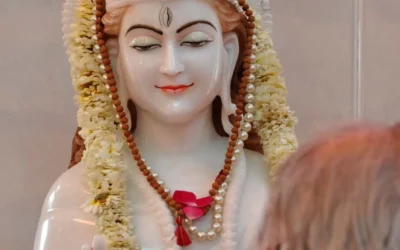A Structured Summary of Vibhuti Pada
Vibhūti Pāda – The Chapter on Accomplishments; the Manifestations of Powers, and Inner Mastery.
Vibhūti – the verb-root for Vibhūti is BHU meaning to be. Prefix Vi means having a verity; Variation and specialization or Distinction.
Therefore, A specialized and distinct variation of one’s being.
So, the Vibhuti pada deals with Vibhutis, all the possibilities of being that the same one Mind/Chitta may manifest, various powers, various forms. Same one becomes many.
The Vibhūti Pāda consists of fifty-five sūtras and forms the third section of the Pātañjala Yogasūtras. This chapter explores the advanced stages of yogic practice, particularly the outcomes that arise from the mastery of concentration and inner absorption—culminating in various forms of siddhis (psychic or supranormal powers).
However, the aim of this chapter is not merely to catalog these powers, but to show the subtle progression of samādhi—the culmination of dhāraṇā (concentration), dhyāna (meditation), and samādhi (absorption)—collectively termed samyama. Patanjali treats these as tools for insight and liberation rather than objects of fascination or worldly pursuit.
The Thematic Summary Of Vibhutipada:
While earlier chapters focus on ethical foundations (Yama, Niyama), postural discipline (Āsana), breath control (Prāṇāyāma), and sense withdrawal (Pratyāhāra), Vibhūti Pāda dives into the inner realms of mind and consciousness. It describes how yogic concentration can dismantle the limitations of space, time, and individuality—but always with the caveat that true Yoga is freedom, not power.
- Establishing Saṁyama: The Central Practice (Sutras 1–8)
Patañjali begins by defining the three internal limbs of yoga: dhāraṇā (concentration), dhyāna (meditation), and samādhi (absorption). Practiced together, they are called saṁyama—a powerful, focused discipline that unlocks direct perception.
This part forms the foundation: the yogi learns how to stabilize and refine the mind into a laser-like instrument.
The central concept introduced here is samyama—a tripartite discipline where dhāraṇā, dhyāna, and samādhi operate in harmony. When applied to different objects, ideas, or experiences, samyama becomes a method of deep intuitive cognition (prajñā). It leads to direct perception beyond ordinary mental functioning.
For example, when samyama is practiced on the strength of an elephant, or on the navel center, specific siddhis like strength or knowledge of body constitution are said to arise. These are metaphors for intuitive perception and inner mastery, not necessarily magical powers in a literal sense.
- Transformation of the Mind (Sutras 9–16)
Once saṁyama is developed, the yogi begins to observe the mind itself—its transitions from activity to silence, from distraction to one-pointedness. These are the pariṇāmas, or inner transformations.
This phase helps the yogi grasp the very mechanics of change, both in the mind and in nature.
- Siddhis: Powers or Distractions? The Subtle Knowledge (Sutras 17–49)
Patanjali presents siddhis not as goals, but as byproducts of deep concentration. These include abilities like telepathy, levitation, knowledge of past lives, invisibility, or even mastery over the elements. However, he also warns (e.g., in sūtra 3.38) that these powers can become obstacles (upasargāḥ) if the yogī gets attached to them.Vyāsa and later commentators, like Vācaspati Miśra and Hariharānanda, emphasize that vibhūtis must not distract from the final aim—kaivalya, the absolute liberation of puruṣa (pure consciousness) from prakṛti (nature).
This is the largest section, where Patañjali shows how saṁyama can be applied to different objects—language, the body, the senses, the elements, time, and cosmic structures—to produce siddhis, or supernatural abilities. These are natural byproducts of mastery over the mind and prāṇa. This part displays the incredible range of perception a yogi can develop.
- Transcending Siddhis; Viveka, and Final Liberation (Sutras 50–55)
The chapter gradually shifts focus from external powers to subtle, inner transformations. There is increasing clarity about the yogī’s discrimination between buddhi and puruṣa, culminating in a transcendental state of independence and freedom.
Sūtras toward the end, like 3.50–3.55, hint at the final threshold before liberation. The yogī becomes a master of all experiential realms, yet remains unattached, establishing firm discrimination (viveka-khyāti) that directly leads into the final chapter, Kaivalya Pāda.
After describing these powers, Patañjali warns against attachment to them. True liberation comes not from enjoying powers, but from rising above them through viveka-khyāti—discriminative insight between puruṣa (the seer) and prakṛti (the seen).
The final sutras return to the essence: pure awareness, beyond even the finest experiences.
Summary in Flow:
- First, the yogi develops the inner method (saṁyama).
- Then, they apply it to observe and purify their own mind.
- Next, they gain extraordinary perception and powers.
- Finally, they renounce even those, and abide in pure awareness.
Vibhūti Pāda :The Thematic Summary Sutra by Sutra
- The Foundation: Antarāṅga Yoga/ The Inner Tools (Sutras 3.1–3.8) This section defines the internal limbs of yoga, Sāṁyama and the mastery of Sāṁyama, and comparing the stages of yoga:
- Dhāraṇā (3.1) → fixing the mind.
- Dhyāna (3.2) → continuous flow of that focus.
- Samādhi (3.3) → when only the object remains.
- Together, these three form Saṁyama (3.4), the master tool of yogic insight.
- Mastery of sāṁyama leads to the light of wisdom (prajñā) (3.5).
- Saṁyama can be applied step-by-step on various levels (3.6), and is more
subtle than earlier limbs (3.7). - But even this is external to seedless samādhi (3.8).
Key idea: The yogi is moving inward, and now has the tool (saṁyama) to access deeper levels of reality.
- The Internal Transformation: Citta-Pariṇāma (Sutras 3.9–3.16) Here, the mind’s transformation is described in detail:
- Nirodha-pariṇāma (3.9): the shift from activity to stillness.
- Praśānta-vāhitā (3.10): calm becomes natural.
- Samādhi-pariṇāma (3.11): transition from distraction to one-pointedness.
- Ekāgratā-pariṇāma (3.12): the mind becomes absolutely steady.
Then, this inner transformation is linked to:
- Universal change (3.13–15)—all things change in dharma, lakṣaṇa, and
avasthā. - Saṁyama on this change (3.16) leads to knowledge of past and future.
Key idea: The yogi starts seeing change itself—first within, then in the outer world.
- Siddhis from Saṁyama: Applications of Inner Insight (Sutras 3.17–49) Now comes the long central section—the fruits of applying saṁyama:
- On language and saṁskāras (3.17–18) → knowledge of all speech, past.
- On minds (3.19–20) → knowing others’ thoughts (with limits).
- On body and senses (3.21–32) → invisibility, overcoming hunger, inner fire, divine senses.
- On subtle perception and cosmos (3.26–30) → sun, moon, pole star,
- On energy centers and intuition (3.31–35) → siddha vision, prātibha,
insight into citta. - On puruṣa and ultimate knowledge (3.36–38) → seeing the Self, divine
senses, but warned not to cling. - On further powers (3.39–49) → entering others’ bodies, levitation, element mastery, perfection of body and senses.
Key idea: The yogi, through mastery of saṁyama, gains powers—but they’re still part of prakṛti.
4. Transcendence of Siddhis and Final Insight (Sutras 3.50–55) Now the turning point:
- Kaivalya arises (3.50) when sattva and puruṣan are equal in clarity.
- Even siddhis must be renounced (vairāgya, 3.51).
- Beware of celestial praise (3.52)—stay humble.
- Final viveka-jñāna (3.53–54) arises through insight into each moment.
- When that insight matures, the yogi gains sarva-viṣaya-jñāna (3.55)—
timeless, total knowledge.
Key idea: Siddhis are not the goal. Only viveka-khyāti—clear discernment of puruṣa—brings true freedom.
So in short:
- 3.1–3.8: The Tool (Saṁyama)
- 3.9–3.16: Inner Transformations
- 3.17–3.49: Powers (Siddhis) through Saṁyama
- 3.50–3.55: Transcending Powers → Viveka → Kaivalya
– OM Tat Sat







0 Comments